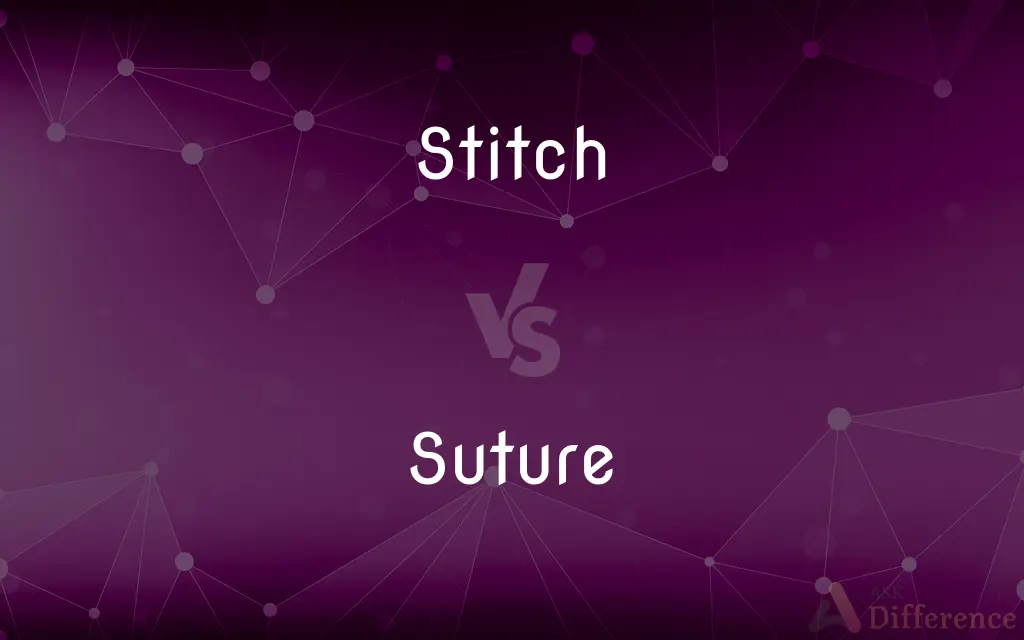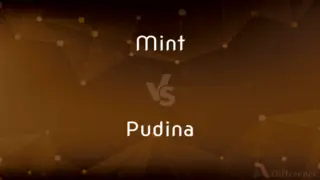Stitch vs. Suture — What's the Difference?
By Tayyaba Rehman & Fiza Rafique — Updated on March 19, 2024
Stitch and suture both refer to the process of closing wounds, but they differ in context and application.

Difference Between Stitch and Suture
Table of Contents
ADVERTISEMENT
Key Differences
A stitch is a single loop of thread or yarn in sewing, knitting, or surgical wound closure. In the medical context, it is often used colloquially to refer to the act of closing wounds with sutures. Sutures, on the other hand, are the actual medical threads used to close wounds or surgical incisions and can be made from various materials, both absorbable and non-absorbable.
While "stitch" is a broader term that can apply to various forms of sewing, in the medical field, it typically refers to one unit of suture. Sutures are specifically designed for medical use, with considerations for tissue compatibility, tensile strength, and the body's healing process. They can be categorized based on their material (natural or synthetic) and whether they are absorbable by the body over time.
The technique used for stitching (suturing) in medicine varies depending on the wound's location, depth, and the need for minimized scarring. Sutures are chosen based on the desired strength and healing time, with some designed to dissolve over time and others requiring removal.
In essence, while "stitch" may refer to the action or the individual loop in both everyday and medical contexts, "suture" specifically refers to the medical material and its use in wound closure, emphasizing the precision and care in surgical and wound-healing practices.
Comparison Chart
Definition
A loop of thread in sewing or a unit of medical wound closure
Medical thread used to close wounds or surgical incisions
ADVERTISEMENT
Context
Broader term in sewing, colloquial in medicine
Specifically medical
Materials
Can be any thread or yarn in sewing; medical sutures have specific materials
Natural or synthetic materials designed for compatibility with body tissues
Purpose
General sewing or colloquially, wound closure
Precise wound or surgical incision closure
Varieties
In sewing, many types based on technique; in medicine, refers to the act of suturing
Various types based on absorbability, material, and intended use in medical procedures
Compare with Definitions
Stitch
A loop of thread in sewing or knitting.
She added a decorative stitch to the hem of the dress.
Suture
Medical thread used for closing wounds or incisions.
The nurse prepared the suture kit for the procedure.
Stitch
Colloquially used in medicine to refer to sutures.
The doctor said I would need a few stitches for the cut.
Suture
Can be absorbable or non-absorbable.
Absorbable sutures were used to avoid the need for removal.
Stitch
Each unit of a suture in a medical context.
The surgeon placed precise stitches to minimize scarring.
Suture
Designed for compatibility with body tissues.
The suture material was chosen for its high tensile strength and minimal tissue reaction.
Stitch
Can be part of a pattern in textiles.
The quilt featured an intricate cross-stitch pattern.
Suture
Types vary based on the surgical need and healing process.
The facial wound was closed with fine, absorbable sutures to reduce scarring.
Stitch
Associated with various techniques in sewing.
The garment's strength depends on the type of stitch used in its construction.
Suture
Used in surgical procedures and wound care.
Sutures were carefully placed to ensure proper healing of the surgical site.
Stitch
A single complete movement of a threaded needle in sewing or surgical suturing
Made multiple stitches.
Suture
The process of joining two surfaces or edges together along a line by sewing.
Stitch
A single loop of thread or yarn made with an implement such as a sewing or knitting needle.
Suture
The material, such as thread, gut, or wire, that is used in this procedure.
Stitch
A single loop or knot of thread used in closing a wound or incision in surgery; a suture.
Suture
The line or stitch so formed.
Stitch
A way of arranging the threads in sewing, knitting, crocheting, or suturing
Used a purl stitch.
Suture
The fine thread or other material used surgically to close a wound or join tissues.
Stitch
A sudden sharp pain, especially in the side.
Suture
The stitch so formed.
Stitch
(Informal) An article of clothing
Wore not a stitch.
Suture
(Anatomy) The line of junction or an immovable joint between two bones, especially of the skull.
Stitch
(Informal) The least part; a bit
Didn't do a stitch of work.
Suture
(Biology) A seamlike joint or line of articulation, such as the line of dehiscence in a dry fruit or the spiral seam marking the junction of whorls of a gastropod shell.
Stitch
To fasten or join with stitches.
Suture
To join by means of sutures or a suture.
Stitch
To mend or repair with stitches
Stitched up the tear.
Suture
A seam formed by sewing two edges together, especially to join pieces of skin in surgically treating a wound.
Stitch
To decorate or ornament, as with stitches
"The sky was stitched with stars" (Mario Puzo).
Suture
Thread used to sew or stitch two edges (especially of skin) together.
Stitch
To fasten together with staples or thread.
Suture
(geology) An area where separate terrane join together along a major fault.
Stitch
To make stitches; sew, knit, crochet, or suture.
Suture
(anatomy) A type of fibrous joint bound together by Sharpey's fibres which only occurs in the skull.
Stitch
A single pass of a needle in sewing; the loop or turn of the thread thus made.
Suture
(anatomy) A seam or line, such as that between the segments of a crustacean, between the whorls of a univalve shell, or where the elytra of a beetle meet.
Stitch
An arrangement of stitches in sewing, or method of stitching in some particular way or style.
Cross stitch
Herringbone stitch
Suture
(botany) The seam at the union of two margins in a plant.
Stitch
An intense stabbing pain under the lower edge of the ribcage, brought on by exercise.
I've got a stitch. I'm going to have to stop and rest.
After about fifteen minutes I got terrible stitch.
Suture
(transitive) To sew up or join by means of a suture.
Stitch
A local sharp pain (anywhere); an acute pain, like the piercing of a needle.
A stitch in the side
Suture
The act of sewing; also, the line along which two things or parts are sewed together, or are united so as to form a seam, or that which resembles a seam.
Stitch
A single turn of the thread round a needle in knitting; a link, or loop, of yarn
Drop a stitch
Take up a stitch
Suture
The uniting of the parts of a wound by stitching.
Stitch
An arrangement of stitches in knitting, or method of knitting in some particular way or style.
Suture
The line of union, or seam, in an immovable articulation, like those between the bones of the skull; also, such an articulation itself; synarthrosis. See Harmonic suture, under Harmonic.
Stitch
A space of work taken up, or gone over, in a single pass of the needle.
Suture
The line, or seam, formed by the union of two margins in any part of a plant; as, the ventral suture of a legume.
Stitch
A fastening, as of thread or wire, through the back of a book to connect the pages.
Suture
The line at which the elytra of a beetle meet and are sometimes confluent.
Stitch
(by extension) Any space passed over; distance.
Suture
An immovable joint (especially between the bones of the skull)
Stitch
(obsolete) A contortion, or twist.
Suture
A seam used in surgery
Stitch
(colloquial) Any least part of a fabric or clothing.
To wet every stitch of clothes
She didn’t have a stitch on.
Suture
Thread of catgut or silk or wire used by surgeons to stitch tissues together
Stitch
(obsolete) A furrow.
Suture
Join with a suture;
Suture the wound after surgery
Stitch
The space between two double furrows.
Stitch
To form stitches in; especially, to sew in such a manner as to show on the surface a continuous line of stitches.
To stitch a shirt bosom.
Stitch
To sew, or unite or attach by stitches.
To stitch printed sheets in making a book or a pamphlet.
Stitch
(intransitive) To practice/practise stitching or needlework.
Stitch
(agriculture) To form land into ridges.
Stitch
To weld together through a series of connecting or overlapping spot welds.
Stitch
To combine two or more photographs of the same scene into a single image.
I can use this software to stitch together a panorama.
Stitch
(more generally) To include, combine, or unite into a single whole.
Stitch
A single pass of a needle in sewing; the loop or turn of the thread thus made.
Stitch
A single turn of the thread round a needle in knitting; a link, or loop, of yarn; as, to let down, or drop, a stitch; to take up a stitch.
Stitch
A space of work taken up, or gone over, in a single pass of the needle; hence, by extension, any space passed over; distance.
You have gone a good stitch.
In Syria the husbandmen go lightly over with their plow, and take no deep stitch in making their furrows.
Stitch
A local sharp pain; an acute pain, like the piercing of a needle; as, a stitch in the side.
He was taken with a cold and with stitches, which was, indeed, a pleurisy.
Stitch
A contortion, or twist.
If you talk,Or pull your face into a stitch again,I shall be angry.
Stitch
Any least part of a fabric or dress; as, to wet every stitch of clothes.
Stitch
A furrow.
Stitch
An arrangement of stitches, or method of stitching in some particular way or style; as, cross-stitch; herringbone stitch, etc.
Stitch
To form stitches in; especially, to sew in such a manner as to show on the surface a continuous line of stitches; as, to stitch a shirt bosom.
Stitch
To sew, or unite together by stitches; as, to stitch printed sheets in making a book or a pamphlet.
Stitch
To form land into ridges.
Stitch
To practice stitching, or needlework.
Stitch
Sewing consisting of a link or loop or knot made by drawing a threaded needle through a fabric
Stitch
A sharp spasm of pain in the side resulting from running
Stitch
Fasten by sewing; do needlework
Common Curiosities
What is a stitch in medical terms?
In medical terms, a stitch refers to one loop of suture material used to close a wound or surgical incision.
Can stitches be self-dissolving?
Yes, stitches can be self-dissolving if made from absorbable suture materials that the body gradually breaks down.
How do doctors decide which suture material to use?
Doctors choose suture material based on the wound's location, the need for flexibility or strength, the desired healing time, and the risk of infection.
How long do stitches stay in before removal?
The duration before stitch removal varies, typically between 5 to 14 days, depending on the wound's location and healing rate.
Are all stitches removed after healing?
Not all stitches need to be removed; absorbable sutures dissolve over time, while non-absorbable sutures require removal once the wound has healed.
Can stitching be done by non-medical personnel?
Non-medical personnel should not perform medical stitching due to the risk of infection and improper wound closure; however, basic sewing stitches are a common skill.
Do stitches leave scars?
All wound closures can potentially leave scars, but proper suturing techniques and care can minimize scarring.
What are sutures made of?
Sutures can be made from natural materials like silk or synthetic polymers, designed to be either absorbable by the body or non-absorbable.
How are stitches removed?
Stitches are removed using sterile scissors and forceps, with each stitch being carefully cut and gently pulled out to avoid damaging the healed tissue.
What is the difference between a stitch and a suture in surgery?
"Stitch" colloquially refers to the act of suturing or the individual loop made, while "suture" specifically denotes the medical thread used for surgical wound closure.
Share Your Discovery

Previous Comparison
Prototroph vs. Auxotroph
Next Comparison
Mint vs. PudinaAuthor Spotlight
Written by
Tayyaba RehmanTayyaba Rehman is a distinguished writer, currently serving as a primary contributor to askdifference.com. As a researcher in semantics and etymology, Tayyaba's passion for the complexity of languages and their distinctions has found a perfect home on the platform. Tayyaba delves into the intricacies of language, distinguishing between commonly confused words and phrases, thereby providing clarity for readers worldwide.
Co-written by
Fiza RafiqueFiza Rafique is a skilled content writer at AskDifference.com, where she meticulously refines and enhances written pieces. Drawing from her vast editorial expertise, Fiza ensures clarity, accuracy, and precision in every article. Passionate about language, she continually seeks to elevate the quality of content for readers worldwide.














































